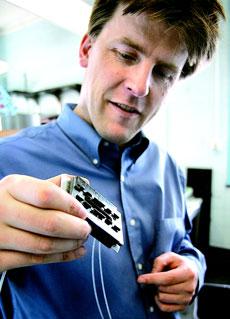Military to test cells

Paul Kenis, professor of chemical and biomolecular engineering, shows a fuel cell he developed that does not contain a solid membrane. Instead, it uses laminar flow to separate the fuel and oxidant. Rick Wiltfong
April 11, 2006
The cutting-edge micro-fuel cell technology developed at the University is looking at test units for the military in early 2007.
The fuel cells were developed at the University in Roger Adams Laboratory 2001. In 2002 Larry Markoski, one of the primary developers, bought an exclusive license for the technology from the University for his company, INI Power Systems. Markoski is president and chief technical officer for INI Power Systems, which has offices in North Carolina and Connecticut.
“We’ve gone from the little startup that could to a big business with a lot of opportunities,” Markoski said.
The micro-fuel cells developed at the University are not the kind that would be used in a car.
“It is important to understand that there are many different types of fuel cells with many different applications,” said Paul Kenis, professor of chemical and biomolecular engineering and a primary developer in the technology. “Some are supposed to power remote cabins, hearing aids, or portable electronics. There is not one power cell technology that can solve all of these needs.”
Get The Daily Illini in your inbox!
INI Power Systems is looking at portable electronic devices, like laptops, as the main application for the micro-fuel cells, Markoski said.
Using fuel cells for portable electronics was hard to achieve with previous models because older cells were too big, Markoski said.
INI’s cell, called the laminar flow fuel cell, is superior to older methanol models because it avoids fuel crossover and cathode flooding, Kenis said.
Fuel crossover happens when the fuel migrates from the cathode, the positively charged plate, to the anode, the negatively charged plate, through the semi-porous membrane. The fuel is wasted on the anode side and this makes the cell more inefficient. Laminar flow ensures that fuel does not crossover.
Cathode flooding occurs when water generated by the reaction of the fuel and oxygen creates water. The water then gathers by the cathode. If the cathode continues to flood it will stop the reaction because the necessary oxygen for the reaction is blocked.
Ordinary methanol fuel cells need water retrieval systems to move the water away from the cathode. The retrieval systems make the cell bulkier and need power to move the water. This results in less total output.
The laminar flow model avoids cathode flooding and, as a result, is longer lasting and more efficient, and smaller.
Very small, microscale channels generate laminar flow in which there is little or no turbulence, Kenis said. This is important because it means that although the fuel, methanol, and oxygen are running side by side there is no need for a membrane to separate them.
Fuel cells are advantageous in general, Markoski said. They have a longer lifetime than current batteries and have zero recharge time. A laptop can run until it is out of methanol. At that point, you would refill it similar to a vehicle.
“A laptop might run two to four hours on a regular battery. But with one of our cells that could be 10 or 20,” Markoski said.
The research at the University was funded through a grant from the Army Research Office.
“We look forward to the deployment of test communications units for the military in early 2007 and we’ve had many offers for more consumer level electronics,” Markoski said.






